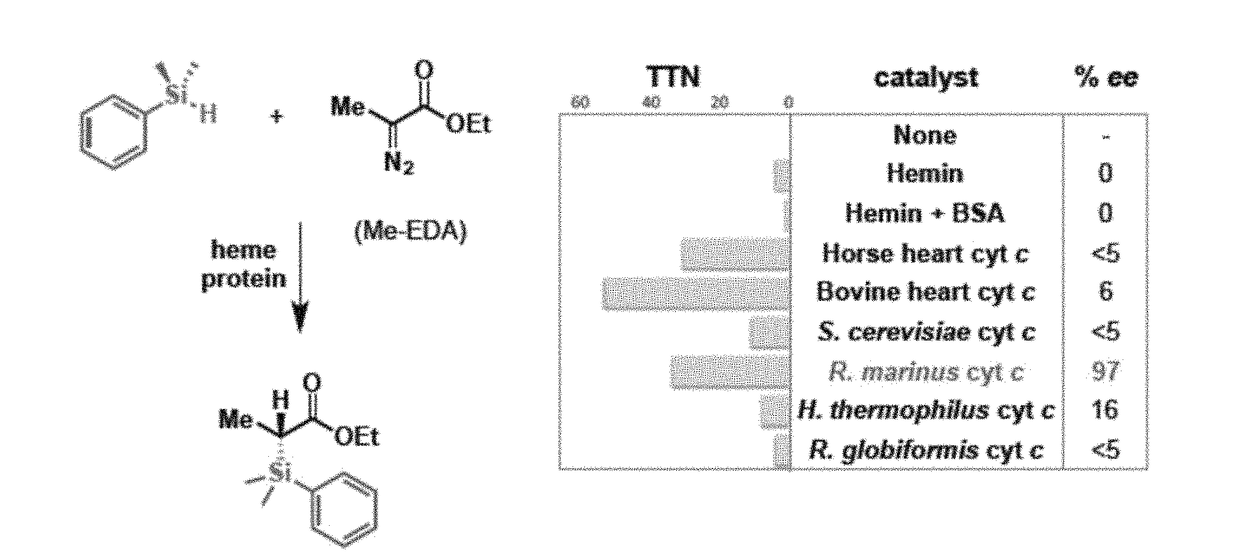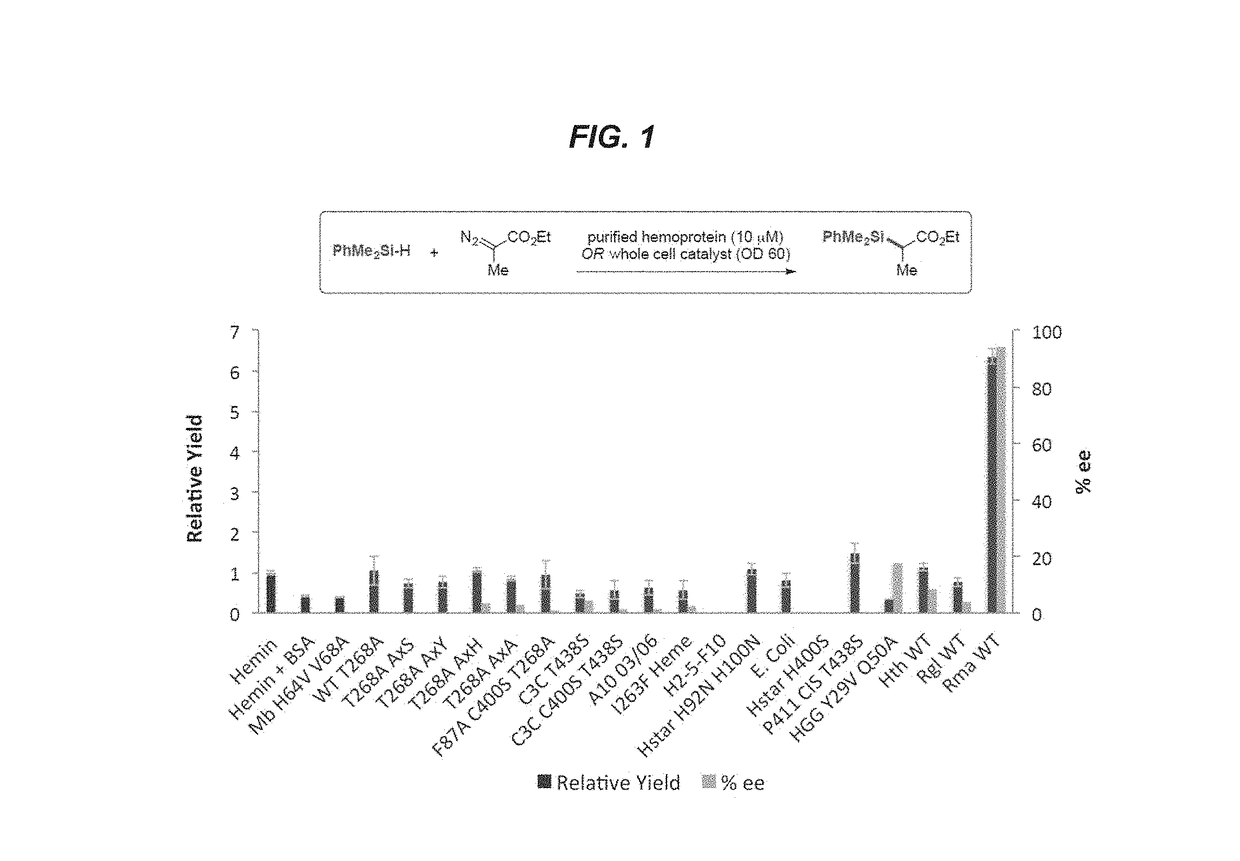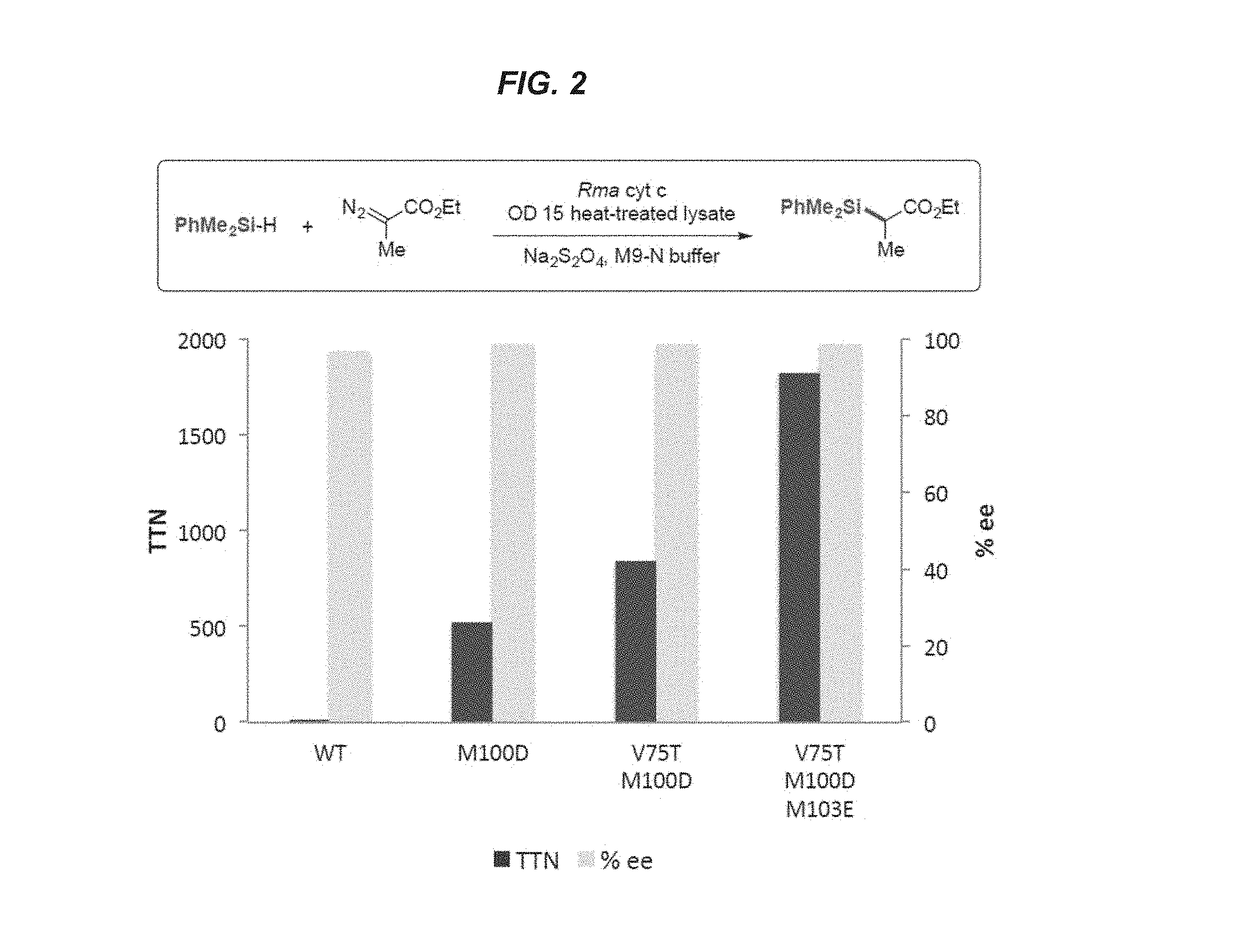Heme Protein Catalysts for Carbon-Silicon Bond Formation In Vitro and In Vivo
a carbon-silicon bond and heme protein technology, applied in the field of synthetic chemistry, can solve the problems of poor turnover, large catalyst structure required to control selectivity, and small fraction suitable for chiral organosilicon compounds,
- Summary
- Abstract
- Description
- Claims
- Application Information
AI Technical Summary
Benefits of technology
Problems solved by technology
Method used
Image
Examples
example 1
Carbon-Silicon Bond Formation to Afford Organosilicon Compounds Using Cytochrome P450 Proteins and Other Heme Proteins
[0183]This example shows the production of organosilicon compounds using various heme proteins, including cytochrome P450 proteins.
P450 Expression and Purification
[0184]One liter Hyperbroth (0.1 mg / mL ampicillin) was inoculated with an overnight culture (25 mL LB, 0.1 mg / mL ampicillin) of recombinant E. coli BL21 cells harboring a pCWori or pET22 plasmid encoding cytochrome P450 variants under the control of the tac or T7 promoter. The cultures were shaken at 200 rpm at 37° C. for roughly 3.5 hours, or until an optical of density of 1.2-1.8 was reached. The temperature was reduced to 20° C. and the shake rate was reduced to 130-150 rpm for 20 minutes, then the cultures were induced by adding isopropyl β-D-1-thiogalactopyranoside (IPTG) and aminolevulinic acid to a final concentration of 0.25 mM and 0.5 mM, respectively. The cultures were allowed to continue for anoth...
example 2
Carbon-Silicon Bond Formation to Afford Organosilicon Compounds Using Rma Cyt c Variants In Vitro and In Vivo
[0187]This example shows the use of cytochrome c protein from Rhodothermus marinus (Rma cyt c) to catalyze the formation of organosilicon compounds.
Cytochrome c Expression
[0188]One liter Hyperbroth (100 μg / mL ampicillin, 20 μg / mL chloramphenicol) was inoculated with an overnight culture of 20 mL LB (100 μg / mL ampicillin, 20 μg / mL chloramphenicol). The overnight culture contained recombinant E. coli BL21-DE3 cells harboring a pET22 plasmid and pEC86 plasmid (Arslan et al. Biochem. Biophys. Res. Commun. 251, 744-747 (1998)) encoding the cytochrome c variant under the control of the T7 promoter, and the cytochrome c maturation (ccm) operon under the control of a tet promoter, respectively. The cultures were shaken at 200 rpm at 37° C. for approximately 2 hours or until an optical of density of 0.6-0.9 was reached. The flask containing the cells was placed on ice for 30 minutes. ...
example 3
Evolution of Cytochrome c for Carbon-Silicon Bond Formation
[0194]This example shows the generation of mutant variants of Rhodothermus marinus (Rma) cytochrome c and demonstrates their ability to act as carbon-silicon bond-forming catalysts in vitro and in vivo.
Introduction
[0195]Silicon constitutes almost 30% of the mass of the Earth's crust, yet no life form is known to have the ability to forge carbon-silicon bonds (1). Despite the absence of organosilicon compounds in the biological world, synthetic chemistry has enabled the appreciation of the unique and desirable properties that have led to their broad applications in chemistry and materials science (2,3). As a biocompatible carbon isostere, silicon can also be used to optimize and repurpose the pharmaceutical properties of bioactive molecules (4,5).
[0196]The natural supply of silicon may be abundant, but sustainable methods for synthesizing organosilicon compounds are not (6-8). Carbon-silicon bond forming methods that introduc...
PUM
| Property | Measurement | Unit |
|---|---|---|
| pH | aaaaa | aaaaa |
| temperature | aaaaa | aaaaa |
| reaction time | aaaaa | aaaaa |
Abstract
Description
Claims
Application Information
 Login to View More
Login to View More - R&D
- Intellectual Property
- Life Sciences
- Materials
- Tech Scout
- Unparalleled Data Quality
- Higher Quality Content
- 60% Fewer Hallucinations
Browse by: Latest US Patents, China's latest patents, Technical Efficacy Thesaurus, Application Domain, Technology Topic, Popular Technical Reports.
© 2025 PatSnap. All rights reserved.Legal|Privacy policy|Modern Slavery Act Transparency Statement|Sitemap|About US| Contact US: help@patsnap.com



